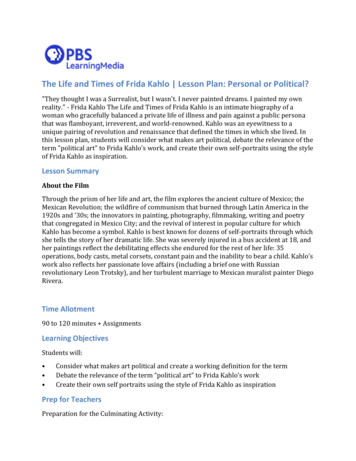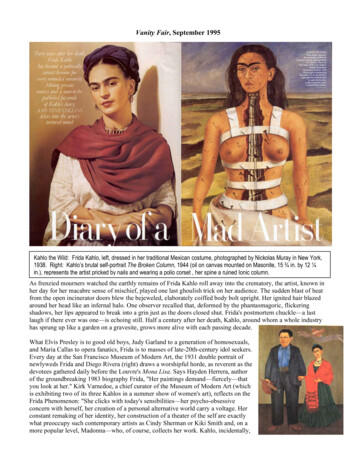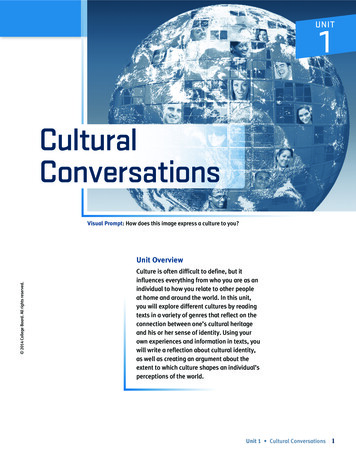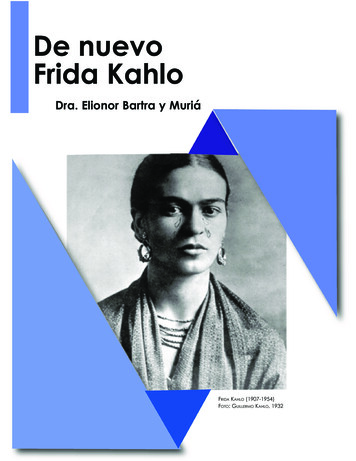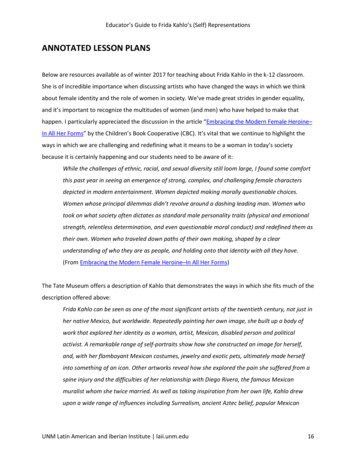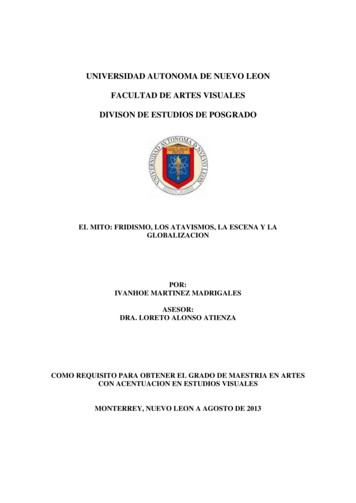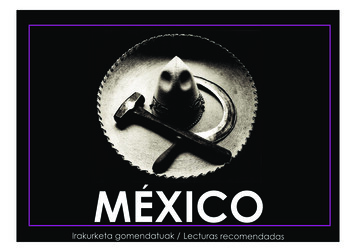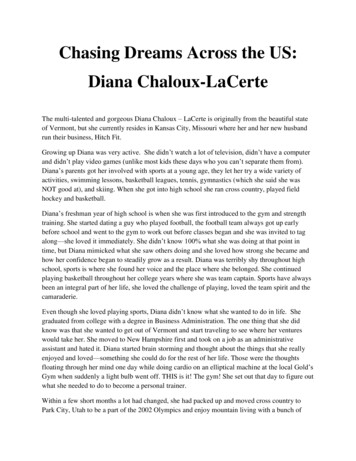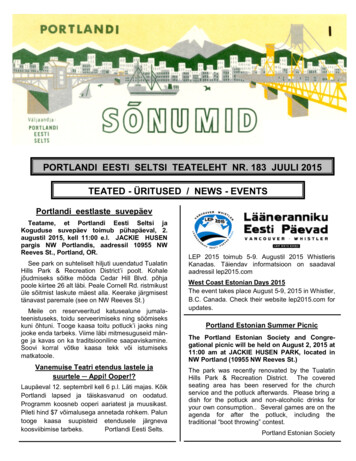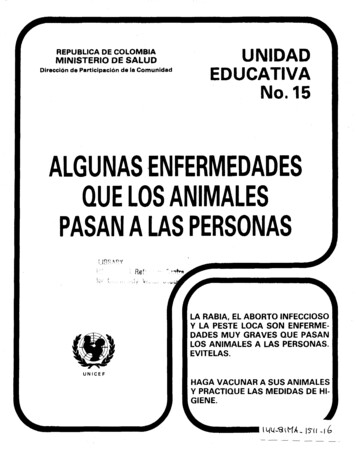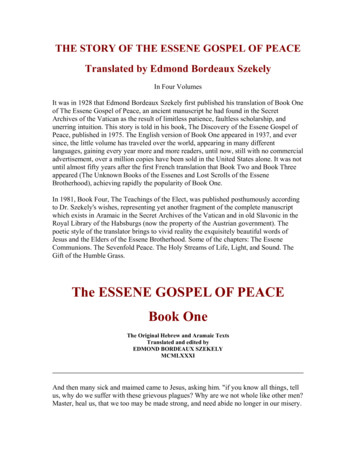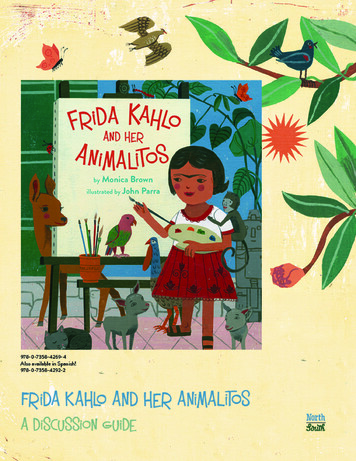
Transcription
Frida Kahlo and her animalitos A discussion guideLearning Objectives:Students will be able to identify character traits, find literal and non-literalmeanings of words and phrases; use strategies to determine the meaning ofunknown words in and out of context, compare and contrast and sequenceevents.Guided Reading Level-NGrade level Equivalent-3Interest Level - Grades 2-5Before Reading: Look at the front cover illustration and the title of the book.The author uses some Spanish words including “animalitos”. Whatdoes the word sound like? What English word do you seen in the word“animalitos”?Name the “animalitos” on the cover of the book and identify the girlas Frida Kahlo.How would you explain the animals in the picture? Are they pets?Where would you find these animals?Why would someone want to write a book about Frida Kahlo and heranimals?How important is it to know about the personal life of an artist wheninterpreting his/her work?Predict what the book will be about based on the cover illustrations andthe title.Word Work mini lesson— What is figurative language?2
Frida Kahlo and her animalitos A discussion guide Why do authors use figurative language in stories?Brainstorm and chart examples of simile, metaphor and hyperboleDiscuss the literal and non-literal meanings.Read and discuss the inferred meaning of the quote on the backcover—“Feet, what do I need you for when I have wings to fly?”—Frida KahloChart and discuss new vocabulary words - Animalitos, spirited, colorful,indigenous, heritage, La Casa Azul, microscope, mist, mischievous, easel,canopy bed, Aztecs, reflection, courtyard, inspiration, and self-portrait.Brainstorm strategies students will use when they come to challengingwords. (Use words around the word to get meaning from context clues,infer, check inferred meaning, look for familiar sounds or parts of words,and break into syllables)Have students classify the text type of Frida Kahlo and her Animalitos.(Biography) and give examples of other biographies they have read.Talk about why it is important to read biographies.Read/listen to find out about Frida Kahlo and her animals, why sheis considered one of the world’s most influential painters and thesignificance of the quote on the back cover.During Reading: Ask and answer such questions; who, what, where, when, why,, and howto demonstrate understanding of key details in a textIdentify the setting, and character traits of Frida KahloDetermine the meaning of words and phrases as they are used in thestory, distinguishing literal from nonliteral language.3
Frida Kahlo and her animalitos A discussion guide Find examples of figurative language and discuss how they enhance themeaning and tone of the story.Determine the central message. Look for evidence in the book to supportthe themes.What can the theme teach you about your own life?Describe how Frida responds to major events and challenges.Describe the overall structure of a story, including how Monica Brownintroduces and ends the storyUse information gained from the illustrations and words to demonstrateunderstanding of the characters, setting, and plot.What information do the illustrations reveal that the words do not?After Reading:1. Describe Frida’s character traits, motivations, and feelings and explainhow her actions contribute to the sequence of events2. Explain the quote-“Feet, what do I need you for when I have wings to fly?”—Frida Kahlo3. Locate and explain descriptive language used by Monica Brown sitingspecific examples from the book Frida’s father taught her to look at the world through curious eyesLike a cat, Frida was playfulThe Little girl played and danced like a kittenLike her monkeys, Frida could be mischievousLike her parrot, Frida was colorfulLike her fawn, Frida had a watchful eye4. How did Frida’s personal life influence her work as an artist?4
Frida Kahlo and her animalitos A discussion guideFind words from the story to support the following statements Frida’s friends were like her.Frida was different from most children.Frida was like her eagle.Frida’s turkeys and dogs were like her.Frida’s “Xolo” dogs were special to her.5. Summarize the book in your own words.6. Write a narrative account telling about Frida Kahlo and her life of passion,pain and love.7. Do you believe she was happy, successful, suffering? Can you besuccessful and suffer at the same time? Explain8. Monica Brown never uses the words “self-portrait”. How does shedescribe this in the story?9. Why do you think she chose this style of painting?10. Plan and design a diorama of a scene from the book that left an impression.Write a few sentences to explain the scene and its significance.11. What questions would ask in an interview with Frida?12. Create a PowerPoint presentation on the Aztec people.13. Name your house. Draw or paint a picture of it.14. Create a class mural of the timeline of Frida’s life. Use colorful illustrationsthat reflect her heritage.5
Frida Kahlo and her animalitos A discussion guide15. Write a journal entry in the voice of Frida Kahlo. This journal entry shouldinclude 3 paragraphs describing an event in Frida Kahlo’s life as if it happened that day. (How they would feel if they were Frida Kahlo on thatparticular day)Think about . . .How does an artist paint his /her autobiography? How would I paint my autobiography?What are the important events in my life that I would want to show in myself-portrait?How can I figure out what the artist is trying to say in his/her artwork?Create . . .A self-portrait using props that say something about yourself.Dig Deeper . . .Essential Questions— Why do artists create self-portraits?How do artists use media, design elements and principles, and their ownpersonal styles to incorporate personal and/or cultural symbolism in theirself-portraits?How did Frida Kahlo use self-portraiture and symbols to express herthoughts, emotions, and values?How did Frida Kahlo use self-portraiture and symbols to express herMexican heritage and personal identity within her culture?How does a self- portrait communicate insights about the artist?6
Frida Kahlo and her animalitos A discussion guideRelate the history facts to Frida Kahlo1. Throughout history, portraiture has been used for self-expression.2. Throughout time, artists have used a variety of media, design elementsand principles, and personal and cultural symbolism in their portraits.3. Effective portraits often reveal insights into the external context andinterior condition of the subject and their heritageSelf-Portrait with Small Monkey [and SeñorXolotl], 1945Self-Portrait with Monkey and Ribbon on theNeck, 1940Instruction Standards in this Guide:Reading ,4b,4c,5,5a,5b,5c,6Speaking & Portrait with Bonito, 19417
5 Frida Kahlo and her animalitos A discussion guide Find words from the story to support the following statements Frida’s friends were like her. Frida was diff erent from most children. Frida was like her eagle. Frida’s turkeys and dogs were like her. Frida’s “Xolo” dogs were
